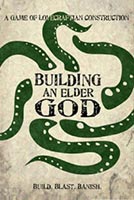
|
About OgreCave and its staff
|

|
by P.J. Cole-Regis
Building an Elder GodPublished by Signal Fire Studios (2012)Designed by Jamie Chambers Ages 6+ Time: 15-30 minutes Players: 2-5 Contents: 104 Tentacle Cards, 10 Necronomicon Tokens, 5 Body Cards, 5 Mouth Cards, 5 Banishment Cards (optional) $19.99 As cultists following the Great Old Ones, you and your peers are attempting to summon an ancient horror back into the world of mortals. However these cosmic elder gods apparently never insist the values of mutual altruism to their followers. Players try to outdo one another's tentacle construct, blasting away at each other's abominations via double-barrel shotguns all the while.
Gameplay The real challenge comes from other players denying you this. Along with the segment cards are blasted segment cards that you can place over other people's monster segments, though the segments must match – if I have a blasted horizontal segment, I must play it over your horizontal segment and not the vertical one. When a section of your horror between body and mouth is damaged, the creature cannot be considered complete. You can heal your monster by placing another segment over the blasted section that matches the two below, or you can use up one of your precious Necronomicon tokens to heal and immunize that section from further accosting. Some segments glowing purple are inherently immune to tampering. All divergent tentacles must also be completed with an eye stalk before the primary tentacle is capped by the horrific maw. As an optional rule, banishment cards with the elder symbol can be shuffled into the deck that makes up the common draw pile. These cards can be used to banish (read: discard) X number of segments from everyone's creature, including your own.
Components and Packaging
Conclusions In the end it comes down to waiting to draw the card you need and every shotgun blast throws you back yet again into the queue of waiting longer for more of the right cards. This could be alleviated if the rectangular cards (only to be played portrait and not landscape) were square tiles that could be oriented in four different positions instead of the limit of two options a portrait-oriented card offers. Smaller squares would also take up less room as Building an Elder God requires a good amount of space already for each participating player to adequately cultivate their creature. As a fan of Cthulhu and Lovecraftian horrors, the theme is great – I love playing any game with tentacles, shotguns, ancient runes, and evil books. However, the game play ran too long for what the game is, and what starts with thematic fun can in the end turn into an exercise in tedium at best and frustration at worst. House rules shortening the necessary segments and increasing Necronomicon token counts for each player could address this issue. This is especially recommended when utilizing the optional elder sign banishment cards which increase play time dramatically.
Links:
Related OgreCave podcasts:
|
||||

